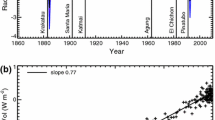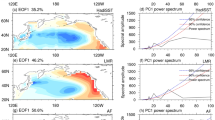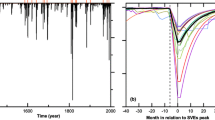Abstract
The Dalton Minimum (1790–1830) was a period with reduced solar irradiance and strong volcanic eruptions. Additionally, the atmospheric CO2 concentrations started to rise from the background level of previous centuries. In this period most empirical climate reconstructions indicate a minimum in global or hemispheric temperatures. Here, we analyse several simulations starting in 1755 with the coupled atmosphere-ocean model ECHO-G driven by different forcing combinations to investigate which external forcing could have contributed most strongly to the reduced temperatures during the Dalton Minimum. Results indicate that on global and hemispheric scales, the volcanic forcing is largely responsible for the temperature drop in this period, especially during its second half, whereas changes in solar forcing and the increasing atmospheric CO2 concentrations were of minor importance. At regional scales, especially the extratropical, the impact of volcanic forcing is much less discernible due to the large regional variability, a finding that agrees with empirical temperature reconstructions.










Similar content being viewed by others
References
Angell JK, Korshover J (1985) Surface temperature changes following the six major volcanic episodes between 1780 and 1980. J Clim Appl Meteorol 24:937–951
Bard E, Raisbeck G, Yiou F, Jouzel J (2000) Solar irradiance during the last 1200 years based on cosmogenic nuclides. Tellus 52B:985–992
Briffa KR, Jones PD, Schweingruber FH, Osborn TJ (1998) Influence of volcanic eruptions on Northern Hemisphere summer temperature over the past 600 years. Nature 393:450–455
Crowley TJ (2000) Causes of climate change over the past 1000 years. Science 289:270–277
Cubasch U, Voss R (2000) The influence of total solar irradiance on climate. Spa Sci Rev 94:185–198
Cubasch U, Voss R, Hegerl GC, Waszkewitz J, Crowley TJ (1997) Simulation of the influence of solar radiation variations on the global climate with an ocean-atmosphere general circulation model. Clim Dynam 13:757–767
Dai JH, Mosleythompson E, Thompson LG (1991) Ice core evidence for an explosive tropical volcanic eruption 6 years preceding Tambora. J Geophys Res 96:17361–17366
Eddy JA (1976) Maunder Minimum. Science 192:1189–1202
Esper J, Cook ER, Schweingruber FH (2002) Low-frequency signals in long tree-ring chronologies for reconstructing past temperature variability. Science 295:2250–2253
Etheridge DM, Steele LP, Langenfelds RL, Francey RJ, Barnola JM, Morgan VI (1996) Natural and anthropogenic changes in atmospheric CO2 over the last 1000 years from air in Antarctic ice and firn. J Geophys Res 101:4115–4128
Foukal P, North G, Wigely T (2004) A stellar view on solar variations and climate. Science 306:68–69
González-Rouco F, von Storch H, Zorita E (2003) Deep soil temperature as proxy for surface air-temperature in a coupled model simulation of the last thousand years. Geophys Res Lett 30:doi:10.1029/2003GL018264
Graf HF, Kirchner I, Robock A, Schult I (1993) Pinatubo eruption winter climate effects: model versus observations. Clim Dynam 9:81–93
Hegerl GC, Crowley TJ, Baum SK, Kim KY, Hyde WT (2003) Detection of volcanic, solar and greenhouse gas signals in paleo-reconstructions of Northern Hemispheric temperature. Geophys Res Lett 30:doi:10.1029/2002GL016635
Hoyt DV, Schatten KH (1993) A discussion of plausible solar irradiance variations, 1700–1992. J Geophys Res 98:18895–18906
Jones PD, Briffa KR, Barnett TP, Tett SFB (1998) High-resolution palaeoclimatic records for the last millennium: interpretation, integration and comparision with General Circulation Model control-run temperatures. The Holocene 8:455–471
Jones PD, New M, Parker DE, Martin S, Rigor IG (1999) Surface air temperature and its changes over the past 150 years. Rev Geophys 37:173–199
Jones PD, Osborn TJ, Briffa KR (2001) The evolution of climate over the last millennium. Science 292:662–667
Kirchner I, Stenchikov GL, Graf HF, Robock A, Antuña JC (1999) Climate model simulation of winter warming and summer cooling following the 1991 Mount Pinatubo volcanic eruption. J Geophys Res 104:19039–19055
Lamb H (1970) Volcanic dust in atmosphere; with a chronology and assessment of its meteorological significance. Phil Trans Roy Soc 266:425–553
Lean JL, Rind D (1999) Evaluating sun-climate relationships since the Little Ice Age. J Atmos Sol Terr Phys 61:25–36
Lean JL, Beer J, Bradley R (1995) Reconstructions of solar irradiance since 1610—implications for climate change. Geophys Res Lett 22:3195–3198
Lean JL, Wang YM, Sheeley NR (2002) The effect of increasing solar activity on the Sun’s total and open magnetic flux during multiple cycles: implications for solar forcing of climate. Geophys Res Lett 29, doi:10.1029/2002/GL015880
Legutke S, Voss R (1999) The Hamburg atmosphere-ocean coupled model ECHO-G. Technical Report No 18. German Climate Computer Center (DKRZ), Hamburg, Germany
Luterbacher J, Dietrich D, Xoplaki E, Grosjean M, Wanner H (2004) European seasonal and annual temperature variability, trends and extremes since 1500. Science 303:1499–1503
Manley G (1974) Central England temperatures—monthly means 1659 to 1973. Q J Roy Meteor Soc 100:389–405
Mann ME, Bradley RS, Hughes MK (1999) Northern Hemisphere temperatures during the past millennium: inferences, uncertainities, and limitations. Geophys Res Lett 26:759–762
Rampino MR, Self S (1982) Historic Eruptions of Tambora (1815), Krakatau (1883), and Agung (1963), their stratospheric aerosols, and climatic impact. Q Res 18:127–143
Rind D, Balachandran NK, Suozzo R (1992) Climate change and the middle atmosphere part II: the impact of volcanic aerosols. J Clim 5:189–208
Robertson A, Overpeck J, Rind D, Mosley-Thompson E, Zielinski G, Lean J, Koch D, Penner J, Tegen I, Healy R (2001) Hypothesized climate forcing time series for the last 500 years. J Geophys Res 106:14783–14803
Robock A (2000) Volcanic eruptions and climate. Rev Geophys 38:191–219
Robock A (2004) Climatic impact of volcanic emissions. In: Sparks S, Hawkesworth C (eds) State of the planet, geophysical monograph 150, IUGG vol 19. American Geophysical Union, Washington DC, pp 125–134
Robock A, Mao JP (1992) Winter warming from large volcanic eruptions. Geophys Res Lett 19:2405–2408
Robock A, Mao JP (1995) The volcanic signal in surface-temperature observations. J Clim 8:1086–1103
Roeckner E, Arpe K, Bengtsson L, Christoph M, Claussen M, Dümenil L, Esch M, Giorgetta M, Schlese U, Schulzweida U (1996) The atmospheric general circulation model ECHAM4: model description and simulation of present-day climate. Rep 218, Max-Planck-Institut für Meteorologie Bundesstr 55, Hamburg, Germany
Sachs M, Graf HF (2001) The volcanic impact on global atmosphere and climate. In: Lozán LL, Grasl H, Hupfer P (eds) Climate of the 21st century: changes and risks. Wissenschaftliche Auswertungen, pp 34–37
Sadler JP, Grattan JP (1999) Volcanoes as agents of past environmental change. Global Planet Change 21:181–196
Self S, Rampino MS, Barbera JJ (1981) The possible effects of the large 19th and 20th century volcanic eruptions on zonal and hemispheric surface temperatures. J Volcanol Geoth Res 11:41–60
Shindell DT, Schmidt GA, Miller RL, Mann ME (2003) Volcanic and solar forcing of climate change during the preindustrial era. J Clim 16:4094–4107
von Storch H, Zwiers FW (1999) Statistical analysis in climate research. Cambridge University Press, Cambridge, pp 484
Wolff J, Maier-Reimer E, Legutke S (1997) The Hamburg primitive equation model HOPE. Technical report No 13. German Climate Computer Center (DKRZ), Hamburg, Germany
Zorita E, von Storch H, González-Rouco F, Cubach U, Luterbacher J, Legutke S, Fischer-Bruns I, Schlese U (2004) Transient simulation of the climate of the last five centuries with an atmosphere-ocean coupled model: late Maunder Minimum and the Little Ice Age. Met Zet 13:271–289
Zwiers FW, von Storch H (1995) Taking serial correlation into account in tests of the mean. J Clim 8:336–351
Acknowledgements
Dennis Bray helped to improve the legibility of the manuscript. We also would like to thank two anonymous reviewers for their very valuable comments. The simulations were carried out on a NEC SX-6 at the German Climate Computing Centre (DKRZ). This work is part of the EU project SO&P.
Author information
Authors and Affiliations
Corresponding author
Rights and permissions
About this article
Cite this article
Wagner, S., Zorita, E. The influence of volcanic, solar and CO2 forcing on the temperatures in the Dalton Minimum (1790–1830): a model study. Clim Dyn 25, 205–218 (2005). https://doi.org/10.1007/s00382-005-0029-0
Received:
Accepted:
Published:
Issue Date:
DOI: https://doi.org/10.1007/s00382-005-0029-0




